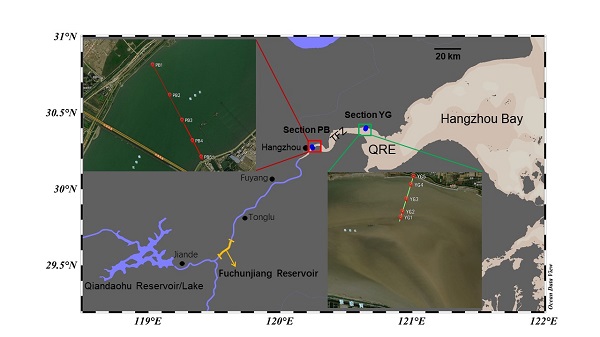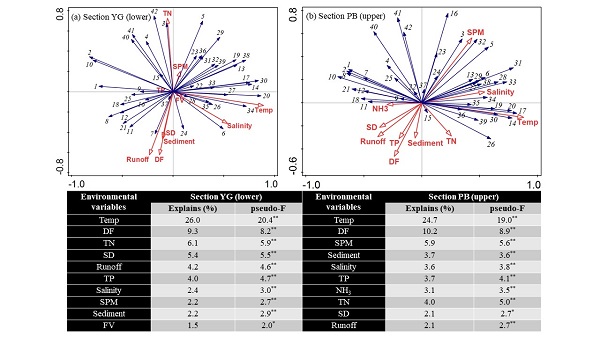Program
Recently, researcher Jiang Zhibing from the Offshore Ecology Team of the Key Laboratory of Marine Ecosystem Dynamics (MED) of the SIO, together with senior engineer Du Wei from Zhejiang Academy of Marine Sciences, published the research paper entitled “Physical Drivers of Monthly Variation in Phytoplankton Community in the Tidal Freshwater Zone of the Macrotidal Qiantang River Estuary, Eastern China: Implications for Reducing the Risk of Harmful Cyanobacterial Blooms” on the geoscience Top journal Journal of Geophysical Research: Oceans. This paper reveals for the first time the annual changes of phytoplankton community, the driving factors and the formation mechanism of cyanobacteria blooms in the Tidal Freshwater Zone (TFZ) of Qiantang River, and puts forward the countermeasures to reduce the risk of cyanobacteria blooms.
Phytoplankton are closely related to water quality and ecosystem health in the TFZ. Qiantang River estuary is a famous macrotidal estuary in the world, so the ecological environment of TFZ of Qiantang River may be deeply affected by river input and saltwater intrusion. In this study, phytoplankton and physical and chemical environment samples were collected from the upper (Pengbu Bridge) and lower (Yanguan) sections of TFZ of Qiantang River during monthly neaps and low tides in 2016 (Figure 1). The results show that phytoplankton abundance and community structure varied significantly in time and space. Freshwater species were dominant in the upper reaches, while coastal low-salt and brackish water species were dominant in the lower reaches. Diatoms were dominant in most months, but cyanobacteria abundance reached its greatest in warm months when runoff was low, which is also closely related to microcystis blooms upstream. Although the salinity in the TFZ of Qiantang River is generally lower than 1, the coastal species such as cyclotella stylorum, skeletonema and thalassiosira are still more dominant, indicating that saltwater intrusion has a great impact on the composition of phytoplankton community.
Redundancy analysis and generalized additive model results show that the composition of phytoplankton community in TFZ is mainly controlled by temperature and Qiantang River flow rather than nutrients (Figure 2), but its abundance changes are jointly affected by temperature, river flow, nutrients and other factors. The cyanobacteria abundance is mainly regulated by temperature, river flow and total phosphorus. Cyanobacteria tends to proliferate, accumulate and form algal blooms in warm months when runoff is low. In the context of eutrophication and warming, harmful cyanobacteria blooms are increasing in the TFZ of global rivers, posing a serious threat to river-estuary ecosystems and human health. To this end, in addition to reducing nutrient input into the watershed, a strategy to reduce the risk of cyanobacteria blooms in TFZ by adjusting river flow during the dry and hot seasons was proposed in the study.
This study revealed for the first time the spatial-temporal variation pattern of phytoplankton in the TFZ of Qiantang River and its driving factors, and enhanced the understanding of the formation mechanism of cyanobacteria blooms in the strong tide section, providing scientific basis and coping strategy for prediction and control of subsequent cyanobacteria bloom evolution.

Figure 1 Sampling area and station location in TFZ of Qiantang River

Figure 2 Redundancy analysis results of phytoplankton community and environmental factors in the upper (PB) and lower (YG) TFZ of Qiantang River
The research was supported by the National Key Research and Development Program (2021YFC3101702 and 2018YFD0900901), the Zhejiang Vanguard (Jianbing) Research and Development Program for Tackling Key Problems (2022C03044), the State Key Laboratory Independent Project (SOEDZZ2202), Monitoring and Evaluation of Resource and Environment Carrying Capacity in Major Estuary Ecosystems of Zhejiang Province (330000210130313013005), the Global Change and Air-Sea Interaction Project Phase II, the LORCE Program, etc.
Paper Citation:
Jiang Z, Du W, Zhu Y, Guo R, Zhan L, Sun Z, Wang D, Zeng J, 2023. Physical drivers of monthly variation in phytoplankton community in the tidal freshwater zone of the macrotidal Qiantang river estuary, eastern China: Implications for reducing the risk of harmful cyanobacterial blooms. Journal of Geophysical Research: Oceans, 128(5), e2022JC019511. https://doi.org/10.1029/2022JC019511.



